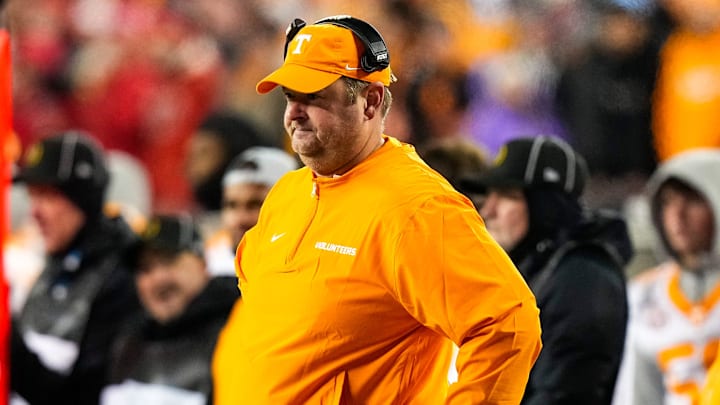The No. 1 wide receiver in the 2026 recruiting class has been committed to LSU since March, but according to recruiting experts, Brian Kelly’s Tigers may no longer be the frontrunners to sign Tristen Keys. Tennessee has been pushing hard to flip Keys from his LSU commitment to pair him with the No. 1 overall player in the class, quarterback Faizon Brandon.
The alluring offensive explosiveness of Brandon and Keys could be the perfect way to rinse the bad taste of Nico Iamaleava’s Transfer Portal departure from the mouths of Vols fans in Knoxville, but that doesn’t mean it’s the ideal way for Josh Heupel to deploy his resources and revenue-sharing dollars.
"If you're a betting guy...take the field over LSU for Tristen Key in the end"@ChadSimmons_ says Tennessee is working hard to FLIP the No. 1 WR in America 🍊
— Josh Newberg (@josh_newberg) July 10, 2025
MORE: https://t.co/UCpCrMJvLc pic.twitter.com/qqhjKVknkS
Josh Heupel’s offense doesn’t need a No. 1 WR to dominate in the SEC
The veer-and-shoot offense, which was introduced by Art Briles and Robert Griffin III at Baylor over a decade ago, is designed specifically to mask offensive talent deficiencies, particularly at the wide receiver position.
The wide splits force defenses to declare whether they’re playing the run or the pass pre-snap, making the read easy for the quarterback, and the stacks and bunch formations prevent defensive backs from jamming receivers. With absurd spacing and consistent free-releases, succeeding as a receiver in the veer-and-shoot system is more about pure speed than route-running ability or, frankly, playing the traditional wide receiver position at all. The route-tree is limited, and the skillset rarely transfers to the NFL game.
From its earliest iteration, Corey Coleman was so effective in the veer-and-shoot with RGIII at Baylor that he became a first-round pick of the Cleveland Browns in the 2015 NFL Draft and lasted just three seasons in the league, never eclipsing 500 yards receiving in any of the three.
More recently, Jalin Hyatt went from a 1,267-yard 15-touchdown season with the Vols in 2022 to a wildly underwhelming NFL career as a third-round pick of the New York Giants. In 2024, his second season in the league, Hyatt finished with just eight catches for 62 yards across 16 games.
That shouldn’t be a concern for Keys, he’s a clear future NFL receiver with a well-rounded game as an X receiver at the college level. At 6-foot-3, he can beat press coverage with quickness and refined footwork, runs every route in the book, and obliterates angles with his long strides once he has the ball in his hands. That concern should be for Tennessee, because if players like Coleman, Hyatt, Squirrel White, Cedric Tillman, and Velus Jones Jr. can become stars in the veer-and-shoot, aren’t the resources that would be allocated to Keys better spent elsewhere on the roster?
Tennessee had issues in the passing game last season. Donte Thornton Jr. led the team in receiving yards despite making just 26 catches all year, and Squirrel White was limited by injury. Teh wide receiver play had a role, but much of those struggles can be easily traced back to the former five-star quarterback whose yards per attempt dropped by over two yards without play-aciton and who had an adjusted completion percentage of just 38 percent on throws over 20 yards downfield, 89th out of 131 QBs with at least 25 such attempts last season.
Offenses evolve and Keys could allow Heupel to iterate on the traditional veer-and-shoot with by far the most talented and complete receiver he’s had in Knoxville. A player like Keys could be the path back to 2022-levels of production for the Vols offense, but so could an elite offensive line with three and four-star players on the outside, benefitting from the structure of Heupel’s offense.
In the true NIL era, Tennessee may not be able to raise the same money from boosters to spend on multiple high-level offensive lineman as they would if the money was earmarked for the top WR in the class. With revenue-sharing money now becoming the primary way to attract talent, spending is the money is in-house and the program can spend it at their own discretion. That allows programs to be more savvy in their team-building process.
There are arguments about what supports a young quarterback more, an elite pass-catcher or high-level offensive line play. I'd argue for the latter, though the former is more flashy and has historically helped elevate QBs to an elite level in college and the NFL. I'd especially argue for spending on the offensive line when your head coach's greatest strength is his offense that is specifically designed to maximize flawed wide receivers.
If Heupel flips Keys, it’s cause for celebration in Knoxville; that fact is undeniable, but with the revenue-sharing era attempting to cap spending, it’s time to have more nuanced conversations about resource allocation in college football. Keys’ potential fit with the Vols and their top QB recruit is worth examining through that lens.
